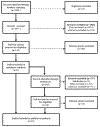Does the association between early life growth and later obesity differ by race/ethnicity or socioeconomic status? A systematic review
- PMID: 28911983
- PMCID: PMC6688753
- DOI: 10.1016/j.annepidem.2017.08.019
Does the association between early life growth and later obesity differ by race/ethnicity or socioeconomic status? A systematic review
Abstract
Purpose: Rapid growth during infancy predicts higher risk of obesity later in childhood. The association between patterns of early life growth and later obesity may differ by race/ethnicity or socioeconomic status (SES), but prior evidence syntheses do not consider vulnerable subpopulations.
Methods: We systemically reviewed published studies that explored patterns of early life growth (0-24 months of age) as predictors of later obesity (>24 months) that were either conducted in racial/ethnic minority or low-SES study populations or assessed effect modification of this association by race/ethnicity or SES. Literature searches were conducted in PubMed and SocINDEX.
Results: Ten studies met the inclusion criteria. Faster growth during the first 2 years of life was consistently associated with later obesity irrespective of definition and timing of exposure and outcome measures. Associations were strongest in populations composed of greater proportions of racial/ethnic minority and/or low-SES children. For example, ORs ranged from 1.17 (95% CI: 1.11, 1.24) in a heterogeneous population to 9.24 (95% CI: 3.73, 22.9) in an entirely low-SES nonwhite population.
Conclusions: The impact of rapid growth in infancy on later obesity may differ by social stratification factors such as race/ethnicity and family income. More robust and inclusive studies examining these associations are needed.
Keywords: Continental population groups; Ethnic groups; Growth and development; Infant; Overweight; Review [Publication type]; Social environment; Socioeconomic factors; Weight gain.
Copyright © 2017 Elsevier Inc. All rights reserved.
Figures
References
Publication types
MeSH terms
Grants and funding
LinkOut - more resources
Full Text Sources
Other Literature Sources
Medical
Miscellaneous


